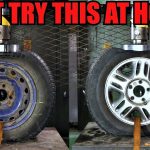Whether new to running flat tyres or looking to make the switch, you can learn what run-flat tyres are, how they work, and how to make the most of them.
What Are Run Flat Tires?
During the 1970s, the tyre industry came out with run-flat tyres designed to allow a vehicle to continue running after a puncture. These tyres are designed with a reinforced sidewall, which helps keep the tyre shape. This design helps support the car’s weight if it is punctured and prevents damage to the wheel.
In addition, the tyre industry has invested billions of dollars in research and development every year to introduce new and innovative products for the consumer. The run-flat tyre has been an option for many drivers who want to avoid waiting for roadside assistance. Using a run-flat tyre is safer for motorists and gives them greater control of their car, even if it is out of air pressure.
A run-flat tyre may be retrofitted to your car or come standard with your vehicle. However, you should always ensure you buy a run-flat tyre compatible with your car; this is important, as some tyres will not support a run-flat tyre.
How Do Run Flat Tires Work?
Having run-flat tyres can make driving after a puncture a lot easier. They are designed to support the car’s weight for up to 50 miles after a puncture; the driver can drive on a flat tyre without stopping, changing the tire, or getting under the car.
Run flats are reinforced sidewalls designed to keep the rubber in place even when the air pressure is low; this helps keep the tire from going completely flat. Also, the thicker sidewall of a run flat helps to carry the car’s weight. These tires also have specialized beads that grip the rim when air pressure is low; this helps keep the rim from breaking the reinforcing cords.
Run flats also have a tyre pressure monitoring system that alerts the driver when the tire is low. It may sound inconvenient, but it’s a major safety issue. The system also lets drivers know when the tire is losing pressure, so they can have a tire change and get back on the road.
What Are The Benefits Of Run Flat Tires
One of the main benefits of run-flat tires is that they are designed to allow you to continue driving on a flat tire. In addition, they are designed to be stronger than a normal tire and have a reinforced sidewall to help prevent your tire from completely blowing out; this is important for safety because a flat tire can cause a crash that could be fatal.
There are two major types of run flat tire systems. The first is a self-supporting tire, which is a tire that has a wall of hard rubber to help the vehicle support the weight of the car. These are popular and may come with a tire pressure monitoring system (TPMS). A second technology is a support ring run-flat tire, which is also popular. These tires have a special rim that is reinforced with a steel ring.
Using run-flat tires can provide peace of mind and convenience. However, there are some drawbacks, too. It can be a difficult choice for some drivers.
The cost to replace a run-flat tire is much higher than a conventional tire. It can cost one-third more or more than twice as much. That is why some tire manufacturers are moving away from running flats. It is also difficult to get a matching replacement. Some tire manufacturers have strict guidelines for repair, and some don’t recommend replacing run-flats with conventional tires.
It is important to call a tow truck if you get a puncture. You don’t want to leave the tire behind. It’s also important to remember that run-flats don’t absorb the effects of potholes as well as regular tires.







